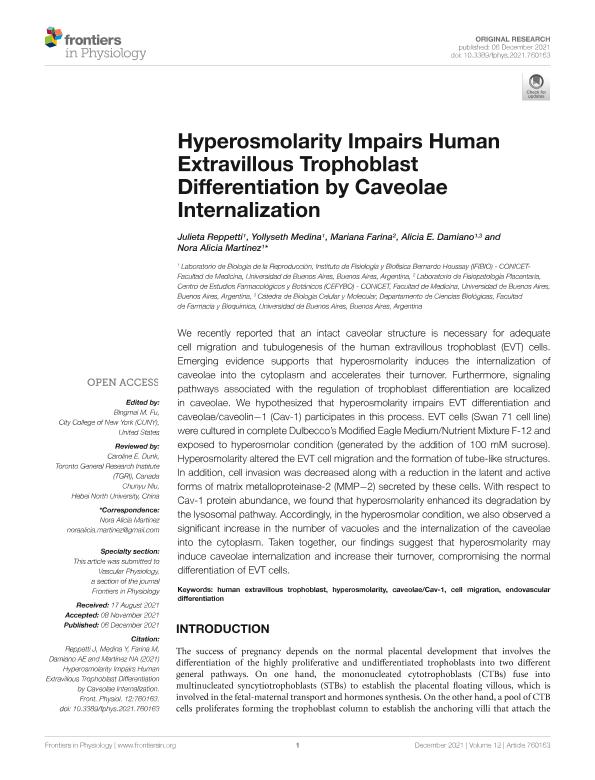Artículo
Hyperosmolarity Impairs Human Extravillous Trophoblast Differentiation by Caveolae Internalization
Reppetti, Julieta ; Medina Mora, Yollyseth Astrid
; Medina Mora, Yollyseth Astrid ; Farina, Mariana
; Farina, Mariana ; Damiano, Alicia Ermelinda
; Damiano, Alicia Ermelinda ; Martinez, Nora Alicia
; Martinez, Nora Alicia
 ; Medina Mora, Yollyseth Astrid
; Medina Mora, Yollyseth Astrid ; Farina, Mariana
; Farina, Mariana ; Damiano, Alicia Ermelinda
; Damiano, Alicia Ermelinda ; Martinez, Nora Alicia
; Martinez, Nora Alicia
Fecha de publicación:
12/2021
Editorial:
Frontiers Media
Revista:
Frontiers in Physiology
ISSN:
1664-042X
Idioma:
Inglés
Tipo de recurso:
Artículo publicado
Clasificación temática:
Resumen
We recently reported that an intact caveolar structure is necessary for adequate cell migration and tubulogenesis of the human extravillous trophoblast (EVT) cells. Emerging evidence supports that hyperosmolarity induces the internalization of caveolae into the cytoplasm and accelerates their turnover. Furthermore, signaling pathways associated with the regulation of trophoblast differentiation are localized in caveolae. We hypothesized that hyperosmolarity impairs EVT differentiation and caveolae/caveolin−1 (Cav-1) participates in this process. EVT cells (Swan 71 cell line) were cultured in complete Dulbecco’s Modified Eagle Medium/Nutrient Mixture F-12 and exposed to hyperosmolar condition (generated by the addition of 100 mM sucrose). Hyperosmolarity altered the EVT cell migration and the formation of tube-like structures. In addition, cell invasion was decreased along with a reduction in the latent and active forms of matrix metalloproteinase-2 (MMP−2) secreted by these cells. With respect to Cav-1 protein abundance, we found that hyperosmolarity enhanced its degradation by the lysosomal pathway. Accordingly, in the hyperosmolar condition, we also observed a significant increase in the number of vacuoles and the internalization of the caveolae into the cytoplasm. Taken together, our findings suggest that hyperosmolarity may induce caveolae internalization and increase their turnover, compromising the normal differentiation of EVT cells.
Archivos asociados
Licencia
Identificadores
Colecciones
Articulos(CEFYBO)
Articulos de CENTRO DE ESTUDIOS FARMACOLOGICOS Y BOTANICOS
Articulos de CENTRO DE ESTUDIOS FARMACOLOGICOS Y BOTANICOS
Articulos(IFIBIO HOUSSAY)
Articulos de INSTITUTO DE FISIOLOGIA Y BIOFISICA BERNARDO HOUSSAY
Articulos de INSTITUTO DE FISIOLOGIA Y BIOFISICA BERNARDO HOUSSAY
Citación
Reppetti, Julieta; Medina Mora, Yollyseth Astrid; Farina, Mariana; Damiano, Alicia Ermelinda; Martinez, Nora Alicia; Hyperosmolarity Impairs Human Extravillous Trophoblast Differentiation by Caveolae Internalization; Frontiers Media; Frontiers in Physiology; 12; 12-2021; 1-12
Compartir
Altmétricas



